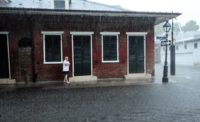The U.S. Army Corps of Engineers is preparing to hand ownership of three new permanent pump stations and storm surge gates on canals in New Orleans to local levee districts that will oversee them for the next century.
The system is the last major piece of a $14.6-billion hurricane-defense system designed after Hurricane Katrina to protect low-lying areas of New Orleans.
The structures at the mouths of the 17th Street, Orleans Avenue and London Avenue canals flowing into Lake Pontchartrain, part of a $693-million project, have been under construction since 2013. Ownership will change hands in January. Work is 97% complete as of late November, with completion set for December.
The project’s biggest challenge of late has been preparing the Coastal Protection and Restoration Authority of Louisiana (CPRA)—the nonfederal sponsor of the project—to operate the stations during the 2018 hurricane season. The Corps has been working with the authority to develop a comprehensive testing plan for the eight weeks of government testing that are part of the contract.
Testing entails running the pumps for extended periods and turning them off and on. During testing, the Corps is helping the CPRA troubleshoot minor bugs while familiarizing the authority with operational issues such as common alarms and their causes and normal equipment temperatures.
“We’re in the middle of that eight-week ‘shakedown cruise’ right now and learning a lot about how the stations operate,” say Brad Drouant, senior project manager for the Corps. “It’s been an excellent opportunity for the nonfederal sponsor to get into the building and gain a level of comfort with their operation before we hand them the keys to the building next year.”
The authority and the local levee districts will operate, maintain, repair and rehabilitate the system.
Schedule Adjustments
The project had been running about six months ahead of schedule and was on track for completion by June, in time for the peak of the 2017 hurricane season. But delays arose over interpretations of design requirements, so the design-build project team decided to stick with the original completion date, says Ignacio Harrouch, chief of the CPRA Operations Division.
“CPRA felt the delay was necessary and prudent to ensure a quality project that meets design requirements for such a large project affecting such a large part of the local population and landscape,” Harrouch says.
The contractor is PCCP Constructors, a joint venture led by Kiewit Louisiana Co. with partners Traylor Brothers Inc. and MR Pittman Group. It is the same team that built the West Closure Complex in Belle Chasse, La., also part of the hurricane-defense system.
Because the design-build nature of the project allowed the contractor to proceed at its own risk during some stages, CPRA had to stay on top of changes as they arose, Harrouch says. The contract called for each completed station to be accepted individually or after all three are complete.
“We decided to accept all three stations from the contractor at the same time, and as a result, the joint venture adjusted resources to complete them closer together. There hasn’t been a delay to the overall contract completion date,” Drouant says.
Working in Neighborhoods
Building three massive pump stations in and around established neighborhoods required extensive planning. Most of the other structures in the flood-control system, such as the Inner Harbor Navigation Canal surge barrier and the Western Closure Complex, are located in the marsh or in less densely populated areas. These three pump stations are next to lakefront restaurants, developed neighborhoods and the University of New Orleans.
The construction team minimized noise and impacts to daily traffic and special events on the lakefront, such as marathons and bicycle races. “We communicated regularly with the neighborhoods through community meetings, email and door hangers about ongoing work so they would know what to expect when loud activities were going on and how long they would last,” Drouant says.
Crews took steps to monitor noise and vibrations and used a GPS system to monitor truck delivery routes to the jobsite. The team also worked to ensure that the design of the structures would be aesthetically pleasing and their exteriors would conform to similar stations in the New Orleans area.
Given the tight urban jobsite and New Orleans’ soil conditions, teams used a specially designed cofferdam, patented by PND Engineers Inc. of Alaska. The system braces cofferdam walls from the outside. That meant the interior of the dam was clear of supports and work would not have to stop to move them. At the 17th Street Canal, the 40-ft to 50-ft-deep cofferdams were as large as a football field and strong enough to support a 300-ton crane within 5 ft of the edge.
One advantage has been having the contractor, the Corps and the sponsor in the same location. That helped prevent construction delays. “It made it easier to meet quickly and resolve issues face to face that may have taken longer via correspondence,” Drouant says.
Critical Protection
The PCCP is part of the Hurricane and Storm Damage Risk Reduction System, the $14.45-billion hurricane-defense project that includes five parishes and consists of 350 miles of levees and floodwalls, 73 nonfederal pumping stations, three canal closure structures with pumps and four gated outlets.
The three main outfall canals are critical to the area’s flood-control system and serve as drainage conduits for much of the city. They run south to north near the Orleans Parish lakefront between the Jefferson Parish line and the Inner Harbor Navigation Canal, with floodwall-topped levees lining each canal. During Katrina, storm surge pushed through floodwalls along all three canals and resulted in catastrophic flooding citywide.
Congress authorized funding for the Corps to design and construct the permanent canal closures and pumps in 2006. But even before work began, the project was pushed back two years after an intense legal battle over project costs, scope and other details among prospective bidders.
A massive contract dispute resulted in the Corps scrapping its original contract with the joint venture of design firm CDM (now CDMSmith) and contractors Brasfield & Gorrie and Gates Construction. After a second bidding process, the Corps awarded the job to the PCCP Contractors JV in April 2013. Notice to proceed on the 44-month project was issued the next month.
The contractor is providing a permanent, sustainable way to reduce the risks of a 100-year storm surge entering the outfall canals—a flood that has a 1% probability of occurring in any given year. “Once the project is complete, Greater New Orleans will have a complete system that will provide more robust and reliable risk protection to the city than ever before,” Harrouch says.
Officials anticipate that the new pump station and floodgate system will prevent future floodwall failures from storm surge. The floodgates are designed to protect canals from a 16-ft storm surge on Lake Pontchartrain.
When fully operational, the three pump stations combined will be able to drain water at 24,000 cu ft per second, enough to fill an Olympic-size swimming pool in 3.63 seconds and the Mercedes-Benz Superdome in less than 90 minutes.
The system consists of permanent gated storm-surge barriers and brick-facade pump stations near the lakefront of the three outfall canals.
Nearly 8,000 tons of reinforcing steel will be used on the job, which surpasses the amount of steel used to build the St. Louis Arch by 2,000 tons. The pumps will be equipped with a stand-alone emergency power supply so the system can operate independently of a public utility.
The new structures will replace the $400-million interim closure and pump stations, built in 2006 after Katrina as a short-term storm-protection measure that was meant to last five to seven years.
Because of anticipated settlement and sea-level rise, the levees that make up the hurricane and storm-damage risk-reduction system will need to be raised continually to stay above the height required to provide protection against a 100-year flood.
“Though the construction will end, the protective work will never end,” Harrouch says. “Levees and the land upon which the other flood-protection features are constructed are constantly settling, necessitating lifting and maintenance. Part of the design process includes estimates of settlement of structures, which will be measured on an ongoing basis to confirm the designs.”
Several of the levee districts are performing levee lifts even before the Corps armors them in order to extend the time required before their next lifts. “This is a smart investment in the system on their part that will reduce their future costs,” Drouant says.






Post a comment to this article
Report Abusive Comment